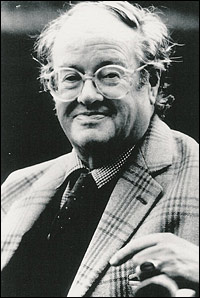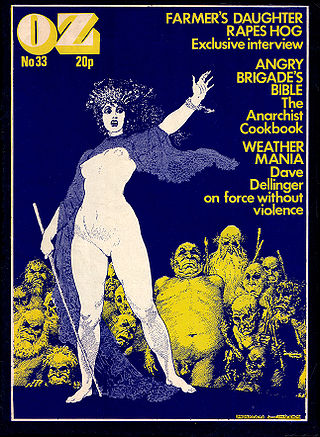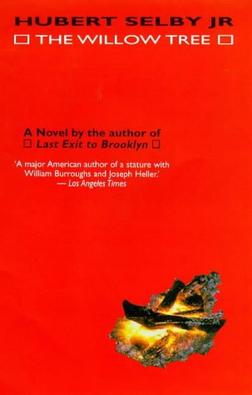
Hubert "Cubby" Selby Jr. was an American writer. Two of his novels, Last Exit to Brooklyn (1964) and Requiem for a Dream (1978), explore worlds in the New York area and were adapted as films, both of which he appeared in.

Sir John Clifford Mortimer was a British barrister, dramatist, screenwriter and author. He is best known for short stories about a barrister named Horace Rumpole, adapted from episodes of the TV series Rumpole of the Bailey also written by Mortimer.

The Soft Machine is a 1961 novel by American author William S. Burroughs. It was originally composed using the cut-up technique partly from manuscripts belonging to The Word Hoard. It is the first part of The Nova Trilogy.

A prosecutor is a legal representative of the prosecution in states with either the adversarial system, which is adopted in common law, or inquisitorial system, which is adopted in civil law. The prosecution is the legal party responsible for presenting the case in a criminal trial against the defendant, an individual accused of breaking the law. Typically, the prosecutor represents the state or the government in the case brought against the accused person.
Transgressive fiction is a genre of literature which focuses on characters who feel confined by the norms and expectations of society and who break free of those confines in unusual or illicit ways.

Oz was an independently published, alternative/underground magazine associated with the international counterculture of the 1960s. While it was first published in Sydney in 1963, a parallel version of Oz was published in London from 1967. The Australian magazine was published until 1969 and the British version until 1973.

Requiem for a Dream is a 1978 novel by American writer Hubert Selby Jr., that concerns four New Yorkers whose lives spiral out of control as they succumb to their addictions.

Gilbert Sorrentino was an American novelist, short story writer, poet, literary critic, professor, and editor.
Meng and Ecker was a British underground comic written by David Britton and illustrated by Kris Guidio. It was published in 1989 by the controversial Manchester-based company Savoy and lasted for nine issues before being banned in 1992 under obscenity laws.
John Mackenzie Calder was a Scottish-Canadian writer and publisher who founded the company Calder Publishing in 1949.
Michael Butterworth is a British author, publisher and campaigner who first became known publicly as an author of New Wave science fiction. He later founded the publishing house Savoy Books with David Britton in 1976 and the contemporary art journal Corridor8 with Sarajane Inkster in 2009. He successfully fought a charge of obscenity against Britton's controversial novel Lord Horror during 1992, the first novel to be banned in England since Hubert Selby Jr.'s Last Exit to Brooklyn in 1967.
Calder Publications is a publisher of books. Since 1949, the company has published many books on all the arts, particularly subjects such as opera and painting, the theatre and critical and philosophical theory. Calder's authors have achieved nineteen Nobel Literature Prizes and three for Peace.
This is a list of works by the English writer Anthony Burgess.

The Willow Tree is a novel written by Hubert Selby, Jr. and was published in 1998. It was Selby's first novel in twenty years, since 1978's Requiem for a Dream.

The Room is the second novel by Hubert Selby Jr., first published in 1971.

Lyman Henry Andrews was an American poet, literary critic and friend of Allen Ginsberg and Robert Lowell, amongst other writers with whom he maintained a lifelong contact. Based since the early 1960s in the United Kingdom, he was acquainted with writers and poets such as William S. Burroughs, Mohamed Choukri and W.H. Auden.

Last Exit to Brooklyn is a 1989 drama film directed by Uli Edel and adapted by Desmond Nakano from Hubert Selby Jr.'s 1964 novel of the same title. The film is an international co-production between Germany, the UK, and the United States. The story is set in 1950s Brooklyn and takes place against the backdrop of a labor strike. It follows interlocking storylines among the working class underbelly of the Red Hook neighborhood, including unionized workers, sex workers, and drag queens.
Last Exit to Brooklyn is a 1964 novel by Hubert Selby Jr.

R v Penguin Books Ltd, was the public prosecution in the United Kingdom of Penguin Books under the Obscene Publications Act 1959 for the publication of D. H. Lawrence's 1928 novel Lady Chatterley's Lover. The trial took place over six days, in No 1 court of the Old Bailey, between 20 October and 2 November 1960 with Mervyn Griffith-Jones prosecuting, Gerald Gardiner counsel for the defence and Laurence Byrne presiding. The trial was a test case of the defence of public good provision under section 4 of the Act which was defined as a work "in the interests of science, literature, art or learning, or of other objects of general concern".
Joseph Leo Anthony Gradwell DSC was a British barrister, a magistrate and a Second World War Royal Navy volunteer, who in July 1942 against orders, led his own RN-adapted trawler HMS Ayrshire and three merchant ships from the disaster of Convoy PQ 17 into Arkhangelsk, Soviet Union.












